Why Use a Flat Top Laser Beam?
Most laser beams are Gaussian, though in certain cases it can be beneficial to have a non-Gaussian irradiance profile. Gaussian beams have a decrease in their symmetric irradiance profiles as the distance from the center of the laser beam cross-section increases. Flat top, or top hat, beams have a constant irradiance profile through the cross-section of the laser beam (Figure 1). Some applications benefit from a constant intensity over a given area, including the processing of semiconductor wafers, nonlinear frequency conversion at high power levels, and materials processing. Compared to Gaussian beams, flat top beams often result in more accurate and predictable results, such as cleaner cuts and sharper edges, but they come with additional system complexity and cost.
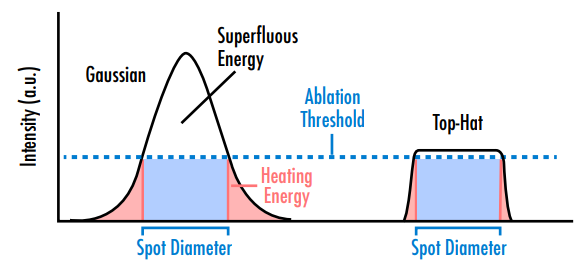
Figure 1: Gaussian beams waste energy through both superfluous energy higher than the threshold required for the application and energy lower than the threshold in the outer portions of the Gaussian beam. Flat top beams are more efficient in that they surpass the threshold while minimizing wasted energy
Gaussian Beams
High-quality, single-mode lasers produce a low-order Gaussian irradiance profile, the TEM00 mode. A Gaussian laser beam at the same average optical power as a flat top laser beam will have a peak fluence twice as large as that of the flat top (Figure 2). Gaussian beams remain constant under transformations; therefore, the beam profile is still Gaussian as the beam propagates through the system, even as the beam size varies. This is because the Fourier transform of a Gaussian function is another Gaussian function. Light goes through a Fourier transform by propagating infinitely far away, or by being focused by a perfect lens. To learn more about laser modes like TEM00, visit our Laser Resonator Modes application note.
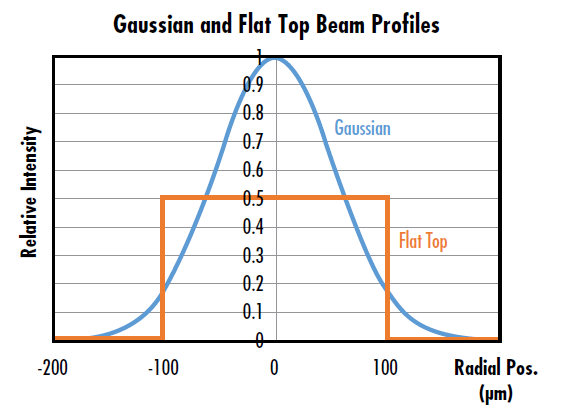
Figure 2: Gaussian and flat top beams at the same optical power, showing the peak intensity of the Gaussian beam is double that of the flat top beam
Gaussian lasers are more common and cost-efficient than other lasers, but they have several disadvantages, such as their “wings,” or low intensity regions extending out from the usable central portion of the beam. The wings of a Gaussian beam often lead to wasted energy if they have an intensity lower than the threshold required for the application (Figure 1). They can also cause damage to surrounding areas and extend the heat-affected zone, which is detrimental in applications such as laser surgery and precise materials processing. Using a Gaussian beam to cut or shape fine features will result in a lower accuracy than that of a flat top beam due to the extended heat-affected zone of Gaussian beams, making a flat top a better option for this type of application.
Flat Top Beams
One way to evaluate how close a real beam is to an ideal flat top beam is by the flatness factor (Fη). This is determined by dividing the average irradiance value by the maximum irradiance value as described in ISO 13694.1
The absence of wings and steeper edge transitions in flat top beams allow for more efficient delivery of energy, as well as a smaller heat affected zone.1 This is beneficial in a wide range of applications where high accuracy and minimized damage to surrounding areas are prioritized. In metrology applications, such as laser induced damage threshold (LIDT) testing, the even and well-defined profile of flat top beams reduces measurement uncertainty and statistical variance. The uniform illumination provided by flat top beams is also beneficial for a wide variety of applications, such as fluorescence microscopy, holography, and interferometry.2 See our Understanding and Specifying LIDT of Laser Components application note for more information about the relationship between laser induced damage and Gaussian and flat top laser beam profiles.
Flat top beams are not as cost-efficient as Gaussian beams, as an additional beam shaping assembly is required to convert the laser’s output into a flat top beam (Figure 3). This beam shaping assembly can be built into the laser source or placed outside of the laser. These additional beam shaping assemblies are sensitive to x-y alignment and dependent on input beam diameter. Flat top laser beams also do not remain constant under transformations; consequently, the beam profile of an incident flat top beam is not naturally preserved as the beam propagates. The Fourier transform of a flat top function is an airy disk function, meaning the flat top beam will eventually evolve into an airy disk.

Figure 3: Animation of a beam profile converting between a Gaussian distribution and a flat top distribution
How to Achieve a Flat Top Beam
In some low-cost and low-performance systems, Gaussian beams are physically truncated using an aperture to create a pseudo-flat top. This wastes the Gaussian wings’ energy but may be effective when cost is a driving factor. For applications that require higher performance and efficient use of costly laser energy, beam shaping optics are used to convert Gaussian beam profiles to flat top beam profiles. Refractive beam shapers allow for uniformity in the distribution of intensity and flat phase fronts. The refractive AdlOptica πShaper Flat Top Beam Shapers create a collimated flat top beam and feature near 100% efficiency with no internal focusing, allowing for high-power input beams (Figure 4 and Figure 5). Their optical design makes holography, microscopy, and system integration suitable, especially over great distances.


Figure 4: Refractive shaping of an incident Gaussian beam to a flat top profile using an AdlOptica πShaper Flat Top Beam Shaper3

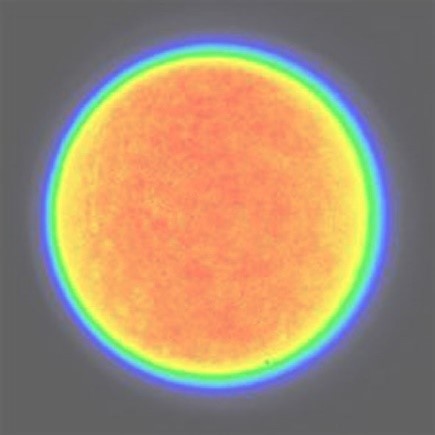
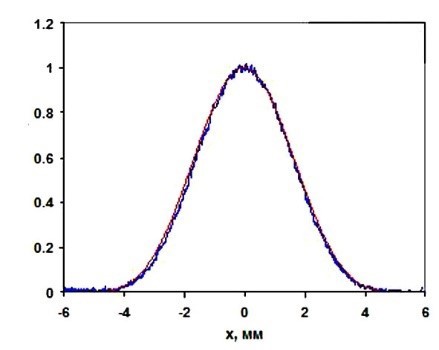

Figure 5: Experimental intensity profiles of an input Gaussian beam (left) and an output flat top beam leaving an AdlOptica πShaper Flat Top Beam Shaper (right)3
The refractive AdlOptica Focal-πShaper Q Flat Top Beam Shapers are another type of beam shaper that converts an input Gaussian beam to a collimated airy disk profile. This forms a flat top focused spot after focusing through a diffraction-limited lens (Figure 6). The compact design and threading on these components make them easy to integrate into various systems. They also feature near 100% efficiency and are suitable in applications where a flat top profile is desired at a focused spot such as lithography, micromachining, and micro-welding.4,5
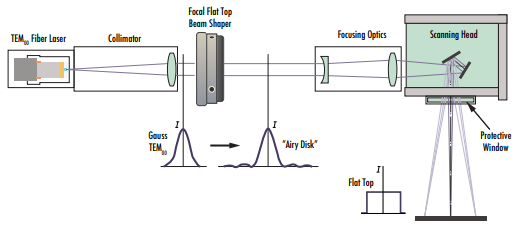
Figure 6: AdlOptica Focal-πShaper Q Flat Top Beam Shapers convert an input Gaussian beam profile into an airy disk profile so that it becomes a flat top beam profile after passing through focusing optics
In addition to refractive beam shapers, Edmund Optics carries other types including reflective, holographic, and diffractive designs. For more information, visit our Beam Shaping page or contact our Application Engineer team for support.
References:
- International Organization for Standardization. (2018). Optics and photonics -- Lasers and laser-related equipment -- Test methods for laser beam power (energy) density distribution (ISO 13694-3:2018).
- Eryilmaz, Marion, et al. “Localization Microscopy Analyses of MRE11 Clusters in 3D-Conserved Cell Nuclei of Different Cell Lines.” Cancers, vol. 10, no. 1, 22 Jan. 2018, doi:10.3390/cancers10010025.
- Laskin, Alexander, et al. “Laser Beam Shaping for Biomedical Microscopy Techniques.” Biophotonics: Photonic Solutions for Better Health Care V, 27 Apr. 2016, doi:10.1117/12.2217927.
- Hung, Yung-Jr, et al. “Employing Refractive Beam Shaping in a Lloyds Interference Lithography System for Uniform Periodic Nanostructure Formation.” Journal of Vacuum Science & Technology B, Nanotechnology and Microelectronics: Materials, Processing, Measurement, and Phenomena, vol. 35, no. 3, 11 Apr. 2017, doi:10.1116/1.4980134.
- Laskin, Alexander, et al. “Refractive Beam Shapers for Focused Laser Beams.” Laser Beam Shaping XVII, 27 Sept. 2016, doi:10.1117/12.2235712.


























본사 및 지사별 연락처 확인하기
견적 요청 도구
재고 번호 입력 필요
Copyright 2023, 에드몬드옵틱스코리아 사업자 등록번호: 110-81-74657 | 대표이사: 앙텍하우 | 통신판매업 신고번호: 제 2022-서울마포-0965호, 서울특별시 마포구 월드컵북로 21, 7층 (서교동, 풍성빌딩)